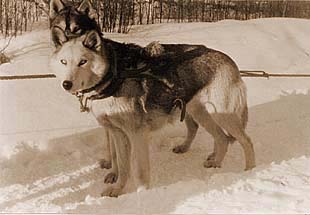The Eva B. Seeley and Lorna Demidoff Bloodlines
THINGS CHANGED as the years wore on, though. Eva B. Seeley had begun her sleddog career by learning to drive a team of Chinooks in the winter of 1929, according to Michael Jennings (page 58, The New Complete Siberian Husky). That same winter she allegedly saw a team of Siberians at the Poland Spring race and decided to become involved with the breed. Seeley leased the Seppala bitch TOTO from Walter Channing and TOTO, mated to Moseley Taylor's leader TUCK, gave birth to the first Seeley Siberian, TANTA OF ALYESKA, on the eleventh of November in that same year of 1929. TANTA was then mated to a shadowy and mysterious male owned by Leonard Chapman and in August 1932 the famous Seeley "foundation litter" by Chapman's DUKE out of TANTA OF ALYESKA was born. The Chinook Kennels breeding programme subsequently moved forward from the base provided by that litter.
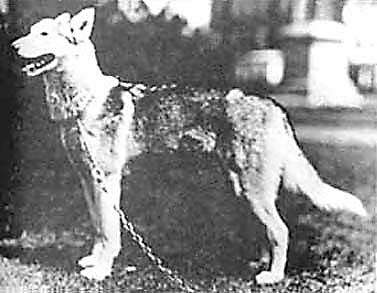
Little information about DUKE survives; Dr. Charles Belford used to tell a strange story about his father's repeated requests to view the dog, and the eventual fulfilment of those requests -- a tale that cast doubt on the dog's origins. No authenticated photos of DUKE survive. It seems strange that so little documentation and so much rumour should surround this male who represented the beginning of the Siberian show-dog bloodlines.
Eva Seeley was an inveterate promoter and publicity-seeker, as well as a person driven by the desire for personal power. In both the Alaskan Malamute and the Siberian Husky breeds she strove for control and domination, and in the main succeeded in getting just that. The evolution of Chinook Kennels' concentration on these two breeds is explained thus by Nancy Cowan (whose knowledge of the subject is far greater than mine):
"Chinook Kennels bred all sorts of sled dogs -- Malamutes, Eskimo sled dogs, Siberian Huskies, some Chinook Dogs, and wolf crosses. But Milton wanted to focus upon a dog breed that would represent Seeley's Chinook Kennels to the world as the Chinook Dog had done for Walden. He fixed their focus on the Malamute, telling Short that the Ricker/Seppala already had a corner on the market for raising Siberians. Short liked the Siberians, and after the dissolution of the Poland Spring kennel, there was no good reason Milton could think of not to breed Siberians."
Chinook Kennels under Milton Seeley's guidance moved in on the high-visibility U. S. Army and U. S. Navy search and rescue business, collaborating with the military and making Chinook Kennels a staging post for collecting and moving sleddogs into training camps and transport groups. The kennel helped with the founding of the Sledge Dog Division for the U. S. Army Quartermaster Corps at Camp Rimini, Montana. It had provided sleddogs for the Second Byrd Antarctic Expedition in 1934, was involved in dog supply for the Third B. A. E. in 1940 and for the U. S. Navy's "Operation Highjump" Antarctic expedition led by Admiral Byrd in 1946. Sleddogs were a hard-nosed business proposition at Chinook Kennels. Milton Seeley saw to that. Nancy explains that he instilled in Short the resolution that they had to produce and sell those dogs so that the kennel should be a profitable business. Short's husband Milton died in 1944; Eva did not forget her lessons; ruthless promotion of Chinook Kennels and of her own Malamute and Siberian Husky bloodlines became an inseparable part of the business plan. (The account by Malamute breeder Robert Zoller, published on the Web as The Zoller Files (MS Word Document download), documents the lengths to which Eva B. Seeley would go to establish and maintain control over a breed.)
Lorna Taylor at first appeared to be an avid dogsled racer. She divorced Moseley Taylor and married Prince Nicholas Alexandrovitch Loupouchine-Demidoff in 1941; as time went by the race trails perhaps meant less and less to her. Increasingly her efforts were concentrated in the breed ring. Make no mistake about it, though -- in the year in which BAYOU OF FOXSTAND was born, Lorna Taylor, soon to be Demidoff, and her Monadnock Kennels would definitely have been considered as belonging to the part-Seppala "Racing Siberian Husky" camp. The Jennings book claims a racing career of twenty years for Mrs. Demidoff.
As the 1940s progressed, though, bench Champions began to flow plentifully from the Monadnock fount. Time progressing, Mrs. Demidoff and Mrs. Seeley began to vie for the coveted honour of producing a flashy, impressive black-and-white blue-eyed Siberian who would be able to compete beyond the Best of Breed level in Group and Show competition. At first it looked as though Eva B. had done it in 1949 with CH. ALYESKA'S SUGGEN OF CHINOOK, whose photo headed the Siberian Husky column in the A.K.C. Gazette for many years. But in 1955 the dog was born that definitively capped the rivalry: CH. MONADNOCK'S PANDO, bred by Mrs. Demidoff by the process described earlier.
Founding of the S. H. C. A.
THE FOUNDING of the Siberian Husky Club of America in 1938 was a key factor of the transformation that occurred through the 1940s and 1950s in the breed. Eva B. Seeley was deeply involved in the founding of the S. H. C. A. and eventually became its Honorary Life President. Michael Jennings writes: " 'Short' continued to remain a dominant force in both Malamutes and Siberians until she died in 1985." He also comments: "today these two breeds [Malamutes and Siberians] -- although not invented by the Seeleys -- are acknowledged to have become what they are largely because of the foundation breeding at this kennel." (References: The New Complete Siberian Husky, pp. 62 and 58.) There is little reason to doubt Mr. Jennings' assertions, except in the case of the original Seppala strain (whose existence as a distinct entity he flatly denies on page 51 of his highly biased book), which owes nothing whatever to any breeding at the Seeleys' kennel. His cautious qualifier, "although not invented by the Seeleys," is certainly correct! The Siberian breed was doing just fine before Eva B. Seeley took a hand in things. A 1938 letter from William Tautges to Dean C. F. Jackson, responding to a notification about the formation of the S. H. C. A., stated:
"My dog, Alaska Kobuk, who was a very fine specimen, died sometime ago. I secured this dog from Julien Hurley, of Fairbanks, Alaska, and I believe that he has some of the finest specimens in America. If you are not already in touch with him, it would be my suggestion that you communicate with him as he can give you some very valuable information in respect to the proper standard as to weight, height, position of ears, carriage of tail, etc."
Ironic indeed, because Dean Jackson was one of Eva Seeley's faction! Somehow one doubts whether Mr. Jackson took up Mr. Tautges' suggestion.
Julien Hurley, the man who had secured A. K. C. recognition and registration of the Siberian Husky, who had registered the first two dozen A. K. C. Siberians, he who wrote the first breed standard, whose kennel unquestionably sheltered the dominant bloodline of the first half of the 1930 decade, remained in Alaska -- far from the growing centre of Siberian Husky breed development and promotion in New England. Oliver Shattuck, the main representative and exponent of the Northern Light bloodline in New England, was a dog man of the old school, conservative, ethical and cautious. He sold dogs only to a few selected persons. He did not seek power for himself, nor did he cover the ground with his dogs' progeny. He sold breeding stock mainly to one or two others, notably C. H. Young. Although he studded his star male CH. NORTHERN LIGHT KOBUCK moderately (KOBUCK's A. K. C. master card shows a total of ten matings), he really took little advantage of the head start he had over the Seeleys or the glory that would have been afforded by having the breed's first bench Champion. Indeed, it seems almost as though Julien Hurley deliberately withdrew from active Siberian breeding as the Chinook Kennels ascendancy started to develop.
The Siberian Dog Suffers a Sea-Change
AT THE PRESENT remove in time it is more than a little difficult to conceive exactly what could have happened at or around the time of the founding of the S. H. C. A. that might have resulted in the sea-change that gradually eventuated in the Siberian Husky breed. Let us recall that it had already existed in the U. S. A. as an A. K. C. recognised breed for eight years before a breed club was founded. Today the true story of the beginning of the Siberian Husky breed is so little known that the S. H. C. A. cannot tell an enquirer which parties initiated the request for A. K. C. breed recognition, or who wrote the first breed standard! In both cases it certainly was not the Seeleys. Further investigation has uncovered an article in the March 1931 A. K. C. Gazette by Fay Clark Hurley stating that the first standard was written by her husband, U. S. Attorney Julien A. Hurley. And the fact that the first two dozen A. K. C. registered Siberians were of the Northern Light lineage is beyond dispute.
What seems obvious is this: that the Siberian Husky, a working sleddog breed already well launched as an A. K. C. purebred, with active breeders in Alaska, Canada and New England, was somehow wrenched off-course by the founding of a highly political breed club almost a decade after breed recognition. Although (perhaps not surprisingly) the means and mechanisms by which this all happened have been forgotten (if indeed they were ever generally known), the final result is clear enough.
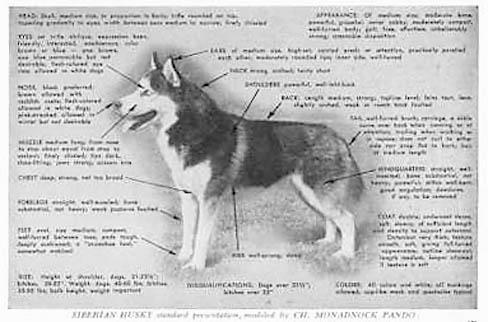
Ch. Monadnock's Pando became the image of the mainstream Siberian Husky
The Seeley bloodline became the Siberian Husky mainstream, or to be a little more accurate, the Monadnock successor bloodline to Seeleys' did. Long before Eva B. Seeley's death in 1985 the influence of her kennel's breeding as such ceased to be felt directly, although it remained strongly dominant through Lorna Demidoff's Monadnock line, as well as through the Anadyr bloodline of Earl F. Norris in Alaska, the Igloo Pak line of Dr. Roland Lombard DVM, and the many minor New England Siberian Husky bloodlines. Nevertheless, although the Seeley bloodline's direct influence was minimal by the 1960s, early broad dissemination of Chinook Kennels stock meant that numerous other bloodlines counted that stock as part of their foundation.
Lorna Demidoff, another S. H. C. A. founder, went from strength to strength in the show ring. After the chain of outside breedings that culminated in CH. VANYA OF MONADNOCK 3rd, most subsequent Monadnock breeding was "within her own kennel" as Jennings puts it. Her last major acquisition was MULPUS BROOK'S THE ROADMASTER (a son of William Belletete's IZOK OF GAP MOUNTAIN) from Jean Lane circa 1954. CH. MONADNOCK'S PANDO was born the following year; with Pando and his look-alike son CH. MONADNOCK'S KING, the Demidoff kennel swept headlong to success in Group and Best in Show competition, to four Specialty Show wins and five consecutive Best of Breeds at the premier Westminster show. Pando became the image of the Siberian Husky breed in the popular mind, aided by the above "visualisation of the standard" illustrated with his photograph. Monadnock's complete domination of the Siberian breed lasted until the current Innisfree dominant line took over. (Show enthusiasts will object with some degree of reason that this is a gross oversimplification of show bloodline history; but the details of exactly how the show bloodlines dominated the breed do not affect the overall outcome.)
The Jacques Suzanne bloodline had a strange fate. Suzanne had an odd reputation as an eccentric and a teller of tall tales. His breeding, based from the outset on the progeny of a single pair of dogs and endlessly inbred thereafter, was carried on for many years. As late as 1970 there were still dogs of his pure bloodline in New England (GYPSY QUEEN, owned by the well-known show breeder Eunice Moreno, was one) and there may still be such, with every pedigree line going back to POLAIRE x DARKA. If so, they would be a tiny handful of dogs only -- an insignificant footnote to the general Siberian population.
Harry Wheeler drove dogs until the late 1940s when the demands of his business became too great; he passed his remaining stock on to J. D. McFaul in 1950, who shared it out with Bill Shearer. Shearer himself closed his kennel in 1956. Cold River kennels closed that same year. None of the Seppala kennels had made any effort to achieve a power base in the Siberian Husky breed or to achieve public exposure and sales of stock via the show ring. Their interests always lay in working or racing sleddogs.
Judge Julien Hurley's Northern Light kennel appears to have registered no stock born any later than 1933 (a handful of Northern Light named animals born in 1939 were bred by Col. Norman Vaughan). Nor did C. H. Young or Oliver Shattuck breed past the same period. By the time World War II began, the once numerous and dominant Northern Light bloodline was no longer much in evidence.
Canadian Seppalas -- and the Preservation of the "SCOTTY" lineage
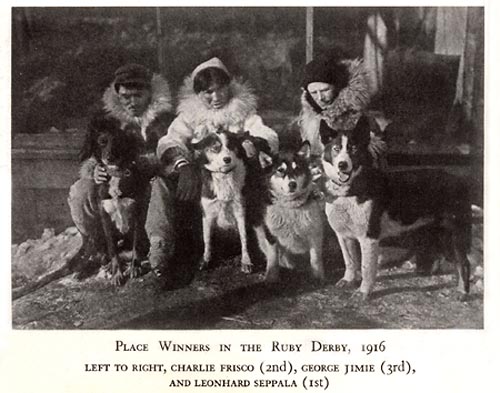
Leonhard Seppala at the 1916 Ruby Dog Derby, "Scotty" at right
SEPPALA STRAIN might also have gone the way of Northern Light, but for two crucial events in Canada. First, in 1939 the Canadian Kennel Club recognised the "Siberian Huskie" breed. It appears that breed recognition and registration were actually resisted by Harry Wheeler, but possibly pressure from A. K. C. and the new breed club was placed upon C. K. C. due to the export of Wheeler stock to the U. S. A. For nine years after A. K. C. recognition the breed had remained unrecognised and unregistered in Canada despite the active two-way traffic in sleddogs. During the 1950s, when Turner and Shearer ceased their activity, Seppalas managed to survive largely because J. D. "Donnie" McFaul of Maniwaki, Quebec, had purchased the remnant of Wheeler dogs in 1950, added FOXSTAND'S SUNDAY and FOXSTAND'S GEORGIA to them, and carried on breeding Seppalas in Canada until his retirement in 1963. At that point there was no successor kennel. The fate of extinction that had threatened the strain in the late 1950s once again loomed large. At almost the last possible moment a naïve would-be rescuer arrived on the scene and the "Markovo rescue effort" got under way in the Canadian province of Ontario.
By an odd turn of fortune, included in the stock used by Markovo Kennels to resuscitate the moribund Seppala bloodline was an excellent bitch, LYL OF SEPSEQUEL (her sister MOKA was also used by Seppineau Kennels), whose pedigree had two Gatineau lines and showed BAYOU OF FOXSTAND in its fourth generation of ancestry. Thus the Northern Light lineage carried by BAYOU was preserved in the "Second Foundation" that gave renewed life to the bloodlines of Wheeler, Shearer and McFaul. Also the unique connection to Leonhard Seppala's 1915 Nome Sweepstakes leader SCOTTY was preserved, which otherwise would have been completely lost to Seppala strain. Due to the overemphasis on TOGO in the 1920s and 1930s, this splendid jet black male's line was not found in any of the Poland Spring stock that happened to achieve registration, unless SCOTTY was one of the unknown ancestors of such Poland Spring dogs as SMOKY. He could well have been.
SCOTTY is a forgotten hero of Seppala strain. He led Sepp's team in the years when he was rising to the top of Alaska racing competition, but was entirely forgotten later, overlooked in the hullabaloo over the Serum Run and the New England adulation of TOGO. SCOTTY's influence was strong in the Northern Light bloodline, inasmuch as Northern Light's famous white lead dog JACK FROST was sired by him. SCOTTY's image now graces the website banners of the International Seppala Association, but that is not the only place in which it is found.
In 1979 the Seppala strain breeding of George Mentis in Minot, North Dakota, mated a Markovo bitch with LYL in her pedigree (ZEITA OF MARKOVO) to a Gary Egelston male (MINTO OF SEPPINEAU) out of LYL's litttermate sister MOKA OF SEPSEQUEL. From that mating was born a bitch, DYNAMIKOS RUBY, who repeated Scotty's genetic markers of jet black colour, dark earlinings, and a white blaze without eyespots. RUBY in turn gave birth to XPACE OF SEPPALTA, who became a foundation dog in the present-day Seppala Kennels in the Yukon Territory, siring a female SCOTTY look-alike, KOLYMA OF SEPPALA, who perpetuates SCOTTY's genetic markers in her progeny and grand-progeny today! It seems remarkable that one dog's genetic heritage can re-emerge after 13 to 18 generations. Nevertheless, today's pedigrees carry multiple repetitions of the BAYOU line through LYL and MOKA OF SEPSEQUEL. The two sisters together make up over 25% of KOLYMA's pedigree lines, so perhaps it is not so surprising that she and her sister TONYA throw SCOTTY-type progeny on occasion.
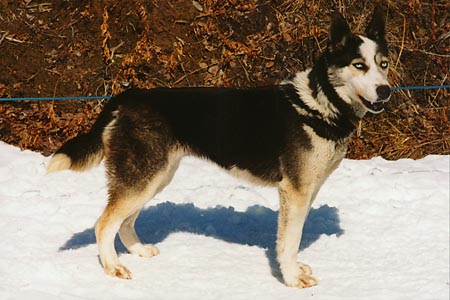
Kolyma of Seppala carries the "Scotty" genetics forward in today's Seppala Siberian Sleddog
Despite his undoubted presence behind present-day Seppala pedigrees and his prestigious status as Leonhard Seppala's mainstay All-Alaska Sweepstakes leader, SCOTTY does not even appear on the "founder list" so often published by the opportunist organisation that has pirated the name of the Seppala Siberian Sleddog, using it to promote the breeding of Racing Siberian Huskies and Alaskan Husky crosses. But then, the ISSSC is not exactly famous for accurate pedigrees anyway.
BAYOU's Message
BAYOU OF FOXSTAND was born in 1940, bred by Joe Booth who trained the Fred Lovejoy team, out of Booth's own leader, DUCHESS OF HUSKYLAND. The latter bitch was born of the mating of an early Cold River leader ROLLINSFORD NINA OF MARILYN to Millie Turner's SAPSUK OF SEPPALA. ROLLINSFORD NINA OF MARILYN had been bred by C. H. Young, daughter of a Seppala-line Shattuck male (KOTLIK) and a bitch sired by CH. NORTHERN LIGHT KOBUCK (NERA OF MARILYN). Joe Booth bred his leader DUCHESS to SURGUT OF SEPPALA, another Turner-owned Wheeler sire. BAYOU was thus three-quarters Harry Wheeler background and one-quarter Shattuck breeding, as can be seen from her pedigree.
BAYOU was sold to Bill Shearer who resold her to J. D. McFaul as a foundation bitch for his Gatineau kennels. Valiant little BAYOU did her utmost to pass on her distinguished ancestry and genetics! She must have been an exceptionally dedicated and skilled brood bitch. She gave birth to seven litters for McFaul between June 1942 and September 1947. Resold then to Earl F. Norris, again as a foundation bitch, she had two more litters in Alaska.
Today, so far as anyone knows, descendants of BAYOU OF FOXSTAND through the Gatineau and Anadyr bloodlines carry the only remaining genetic traces of the Northern Light bloodline that was responsible for the first 25 A. K. C. Siberian Husky registrations and the first A. K. C. bench champion, NORTHERN LIGHT KOBUCK. Although at one time Millie Turner, Lorna Demidoff, Col. Norman Vaughan and others owned or bred to Northern Light dogs, today it is as though the kennels of Julien Hurley, Elsie Reeser, Oliver Shattuck and others who owned Northern Light stock were the losing tribe in some Old Testament battle -- all their children slaughtered, all their habitations thrown down, not one stone left standing upon another, their fields sown with salt.
All, save BAYOU OF FOXSTAND, who somehow survived to give birth to nine litters of progeny. Little BAYOU who managed against all odds to provide us today with a living memory of the 1930s.
"And I only am escaped alone to tell thee" . . .
Consider the Parallels Today . . .
SEPPALA STRAIN itself only quite narrowly escaped the fate of the Northern Light bloodline. The S. H. C. A., its writers and its breeders have often tried to deny the existence or the uniqueness of Seppala strain and have ignored it except when an injection of soundness was needed for another bloodline. The message of BAYOU OF FOXSTAND and her pedigree tell us how easily a respected, valuable, established, numerous bloodline can become lost utterly in the dirty scuffle of dog politics, breed promotion and factionalism. Those who read this article today might reflect upon BAYOU's message and try to work out its implications in the present. Today we have a unique situation with respect to the Seppala Siberian Sleddog and the effort to launch it as a breed in its own right. This situation, it seems to me, has multiple parallels and resonances in the 1930s and the 1940s. But, not to be tiresome and allegorical, I prefer to leave the reader to discover and to ponder those similarities without further assistance from me.
